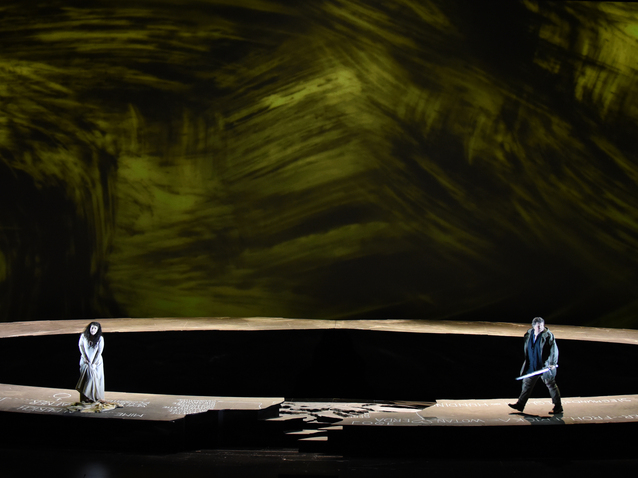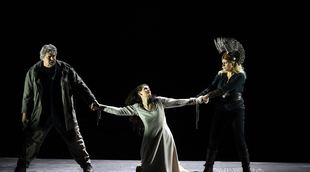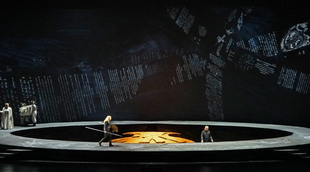 © OFS/Foster
© OFS/Foster
March 19th 1967 is the birthday of the Salzburg Easter Festival, a creation of classical superstar Herbert von Karajan in his search of optimized conditions for the performing arts. Walkuere and the Ring der Nibelungen were his first projects to be realized together with the Berlin Philharmonic and a world class cast. Since then, the Easter Festival has gained a top position in the international festival calendar and a reputation for outstanding production for a small and exclusive circle of classical music lovers.
For its 50th birthday, the management has realised a dense and high quality programme with a number of the best artists accompanied with the Viennese and Berlin Philharmonics as well as the Staatskapelle Dresden, the current residence orchestra of the festival. The highlight is a remake of the first ever performed opera of the festival, Richard Wagner's Walkuere in the legendary original set design of Guenther Schneider Siemssen. Impressed and influenced by Wieland Wagner's revolutionary new directing style of Wagner Operas, removing all the pathos and romantic overloading set design, replacing it with epic narrative. Herbert von Karajan and Guenther Schneider Siemssen’s aim was to "maintain the unity of the form", achieved by interchangeable elements of set design to be reused over the whole cycle. A huge ellipse is a central installation as is the intelligent light design, which actually contains various effects which needed new technical inventions. The critics were ambivalent but the team Von Karajan/ Schneider Siemssen wrote history with their spiritual production and outstanding musical performance.

The Valkyrie - Salzburg Easter Festival (2017)

The Valkyrie - Salzburg Easter Festival (2017)
And now, 50 years later, the set design of Guenther Schneider Siemssen on the enormous stage of the Festivalhall still impresses the audience. It is the tasteful reduction to strong aesthetic images dived into warm emotional light. Vera Nemirova has successfully realized the Ring in Frankfurt and has taken over the overall direction of this remake. A lot of the old production has survived as well some major changes have been done to modernize and meet the current expectations of the audience. Masks and costumes have been new designed, light effects and videos adapted. The overall cosmic atmosphere has certainly survived and gained the consent. German style Regietheater is reduced; the optical effects are dominant; as is the musical interpretation by Christian Thielemann. Like a painter he designs a most colourful atmosphere full of romantic sound as well as abstract images for a clear modelling and characterization. The whole orchestra present itself in perfect condition and even if it is the last evening of a long and intense festival week they play fresh, engaged and with their heart. Every little detail of the partitura arises out of the pit, listening to the orchestra is an exact company to the play. Perfection is an attribute to Thielemann access to this performance.
Again a world-class cast has been selected. Anja Hateros demonstrates the exceptional heights of her voice, clear and precise and flexible in expression as Sieglinde. Peter Seiffert succeeds as the young wild Siegmund, whereas his voice shows better form than his appearance on stage. Georg Zeppenfeld is a secure Hunding who attracts a lot of attention and interest by his play. Anja Kampe opens the second act as the heroine Bruenhilde. This demanding role is top end for Wagnerian sopranos and Anja Kampe is on the way to position herself. With her excellent technique she is well understandable, fresh and mostly easy acclaiming the jumps high up and down. Never shrill, full of flavor in the middle she lacks a little bit weight in volume. Wild and fierce appears Godfather Wotan by Vitalij Kowaljow. Veiled in his fur coat with his long grey hair he gains respect and authority once he opens his mouth and his voice is flooding the concert hall. A powerful timbre, good pronunciation and a swelling presence he earns a lot of tribute by the audience. Christa Mayer is an elegant Fricka, more of an aristocrat than a goddess. Her fight with Wotan remains more a conversation than a destined dispute for divine power. Everybody could feel the tension and the stormy expected confrontation of Wotan and his beloved daughter Bruenhilde once Christian Thielemann pushes his orchestra into the famous ride of the Walkyrias. It is explosive, demonic and fierce. Much more is happening in the music compared to the simple visual effects and static on stage. It seems the phantasy of the director team has diminished. The concept of reanimating extraordinary directions is worth a trend as long as the cast and overall performance matches the expectations as happening in Salzburg.
Helmut Pitsch
the 20 of April, 2017 | Print
Comments